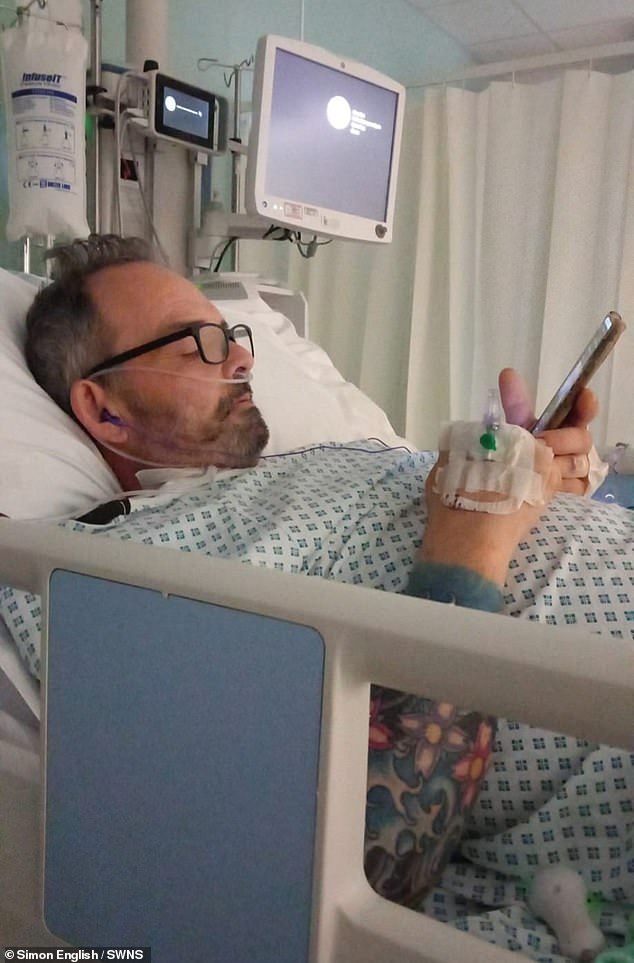Firefighter’s ‘cold’ was actually deadly flesh-eating bacteria that attacked his BUTTOCK, leaving him disabled
A former firefighter was left fighting for his life after what he thought was a ‘bad cold’ turned out to be a flesh-eating insect ‘munching’ through his bottom like a shark.
Simon English, 55, spent three months in intensive care where he ‘nearly died’, eventually having to undergo a procedure to create a stoma so his wound could heal.
“I look like a shark took a bite out of my ass,” said Mr English, a retired firefighter Beverly, Yorkshire.
‘I ended up looking like I was about 70 years old after weeks of lying in bed.
“My nurse told me that if I had left it any longer before going to the hospital, I wouldn’t be here right now.”
Mr English’s ordeal began in late March, when he developed all the classic symptoms of a cold.
His wife, Kay, works at a school and is “always dealing with illnesses,” so the couple assumed his illness was nothing unusual.
But as the hours passed, his symptoms – fever, cough and fatigue – became worse.
Simon English spent three months in intensive care while doctors treated him for a life-threatening infection that started in his buttock.

Necrotizing fasciitis is thought to affect between 500 and 1,000 people in Britain every year, with around one in five patients dying from the infection.
The next day he knew ‘something was wrong’ and took himself to the hospital.
“The next two weeks are such a blur,” he said, admitting he doesn’t remember much of what happened next.
‘They gave me a lot of morphine, I hallucinated a lot. And when I came in two weeks later, a doctor told me I had a condition called necrotizing fasciitis.”
Necrotizing fasciitis, also called the “flesh-eating disease,” is a rare and life-threatening infection that begins in a wound.
It progresses quickly after being caused by several types of bacteria, including group A streptococci and staphylococci.
Occasionally the bacteria can become life-threatening if it invades parts of the body, such as the blood, muscles or lungs.
Symptoms include small, red bumps or bumps on the skin, fast-spreading bruising, sweating, chills, fever and nausea.
Organ failure and sepsis are also common complications.

Mr English was fitted with a colostomy bag, in which one end of the colon is diverted through an opening in the abdomen. The waste products then collect in a bag attached to the opening.
Patients require immediate treatment to prevent death, and are usually given powerful antibiotics and surgery to remove dead tissue.
The mortality rate for the infection is high – and Mr English said his doctor told him one in five patients will not survive.
While in hospital, he was rushed into surgery to cut out the infection on his left buttock – which had started with a small cut that he hadn’t even noticed.
“I’ve had four surgeries,” he said. “They treated (the wound) and sent me back to the intensive care unit.”
About four to five days after he came round, he was sent for a skin graft on his buttock, which involved taking the skin from his right leg.
His body rejected the first transplant, but the second one ‘stuck’ and a two-month rehabilitation period in hospital began.
“I had to walk around the hospital with a walker,” he said. “I spent another two months in the hospital so the wound could heal.”
The infection was so serious that doctors recommended an emergency colostomy to allow the wound to heal properly.
Mr English is still waiting for the reversal procedure to be completed.
After being released from hospital in June, the retiree is slowly returning to ‘normal’ life.
He hopes to be able to work as a volunteer gardener again soon.
“Apart from my stoma, I’m completely healed,” he said.
‘My wound is completely healed, even if it looks a bit strange, because of my skin graft.
‘The surgeon said to have it all over your buttock so it’s out of sight.
“I’ve started doing odd jobs here and there, and I’d like to be a part-time gardener again.”
